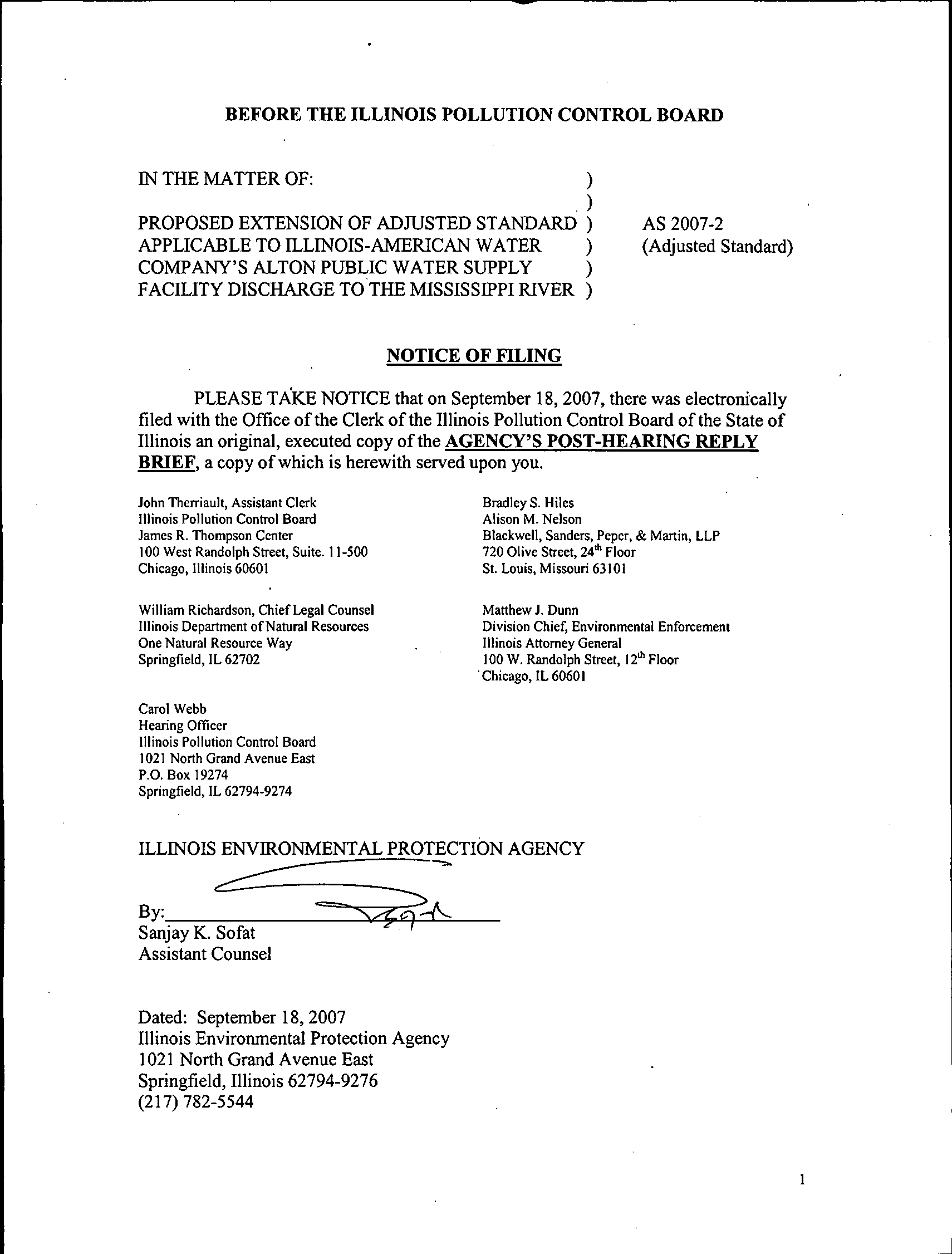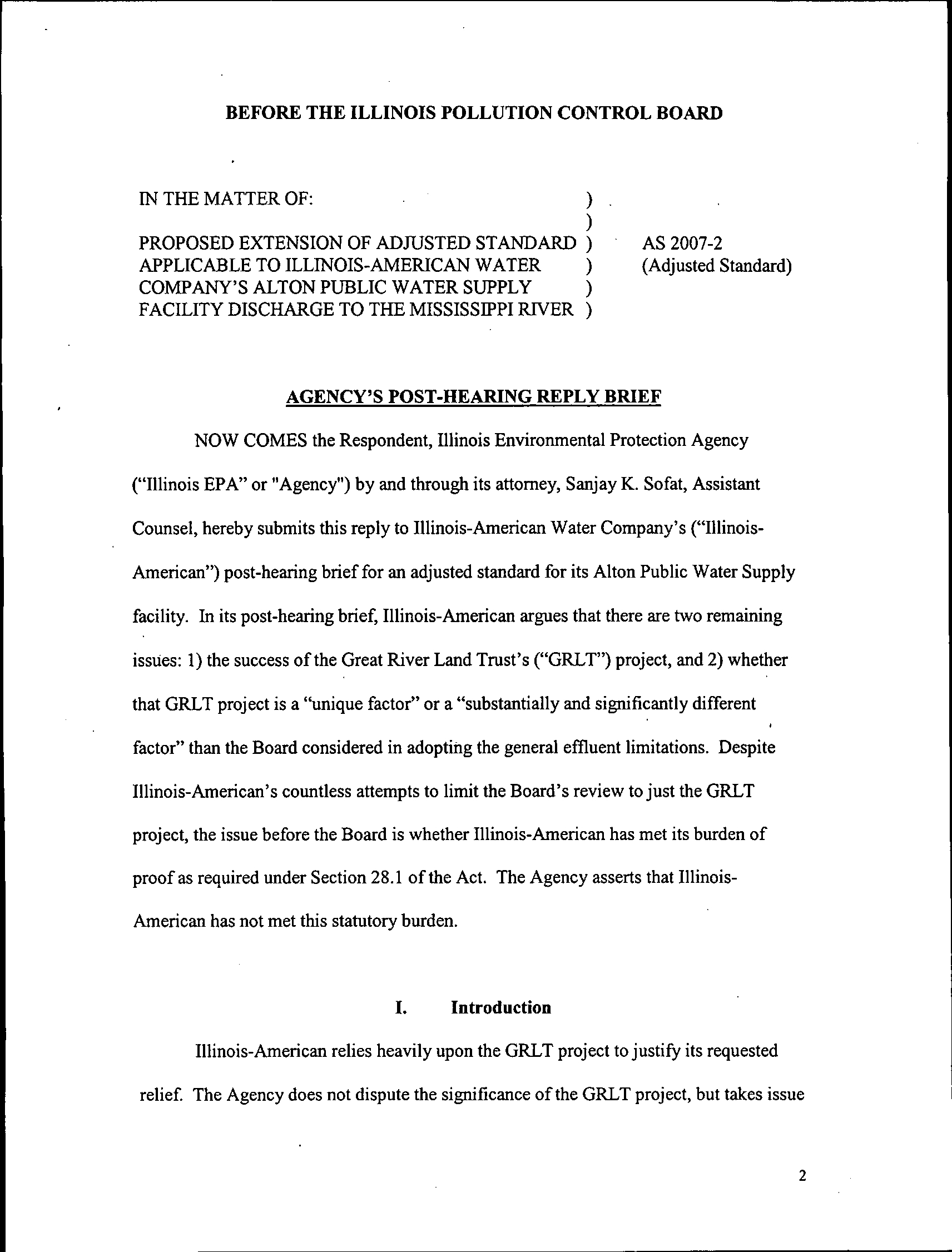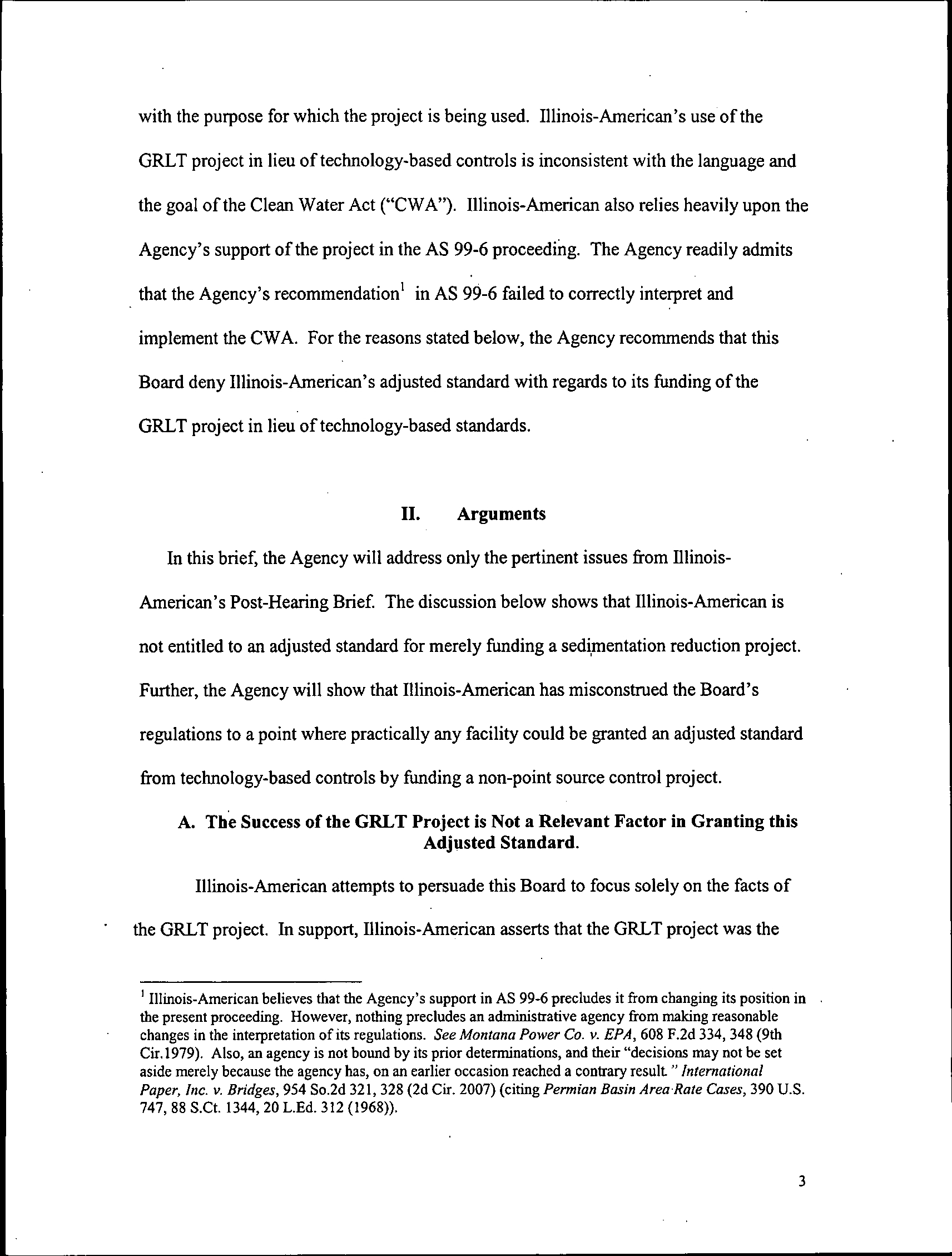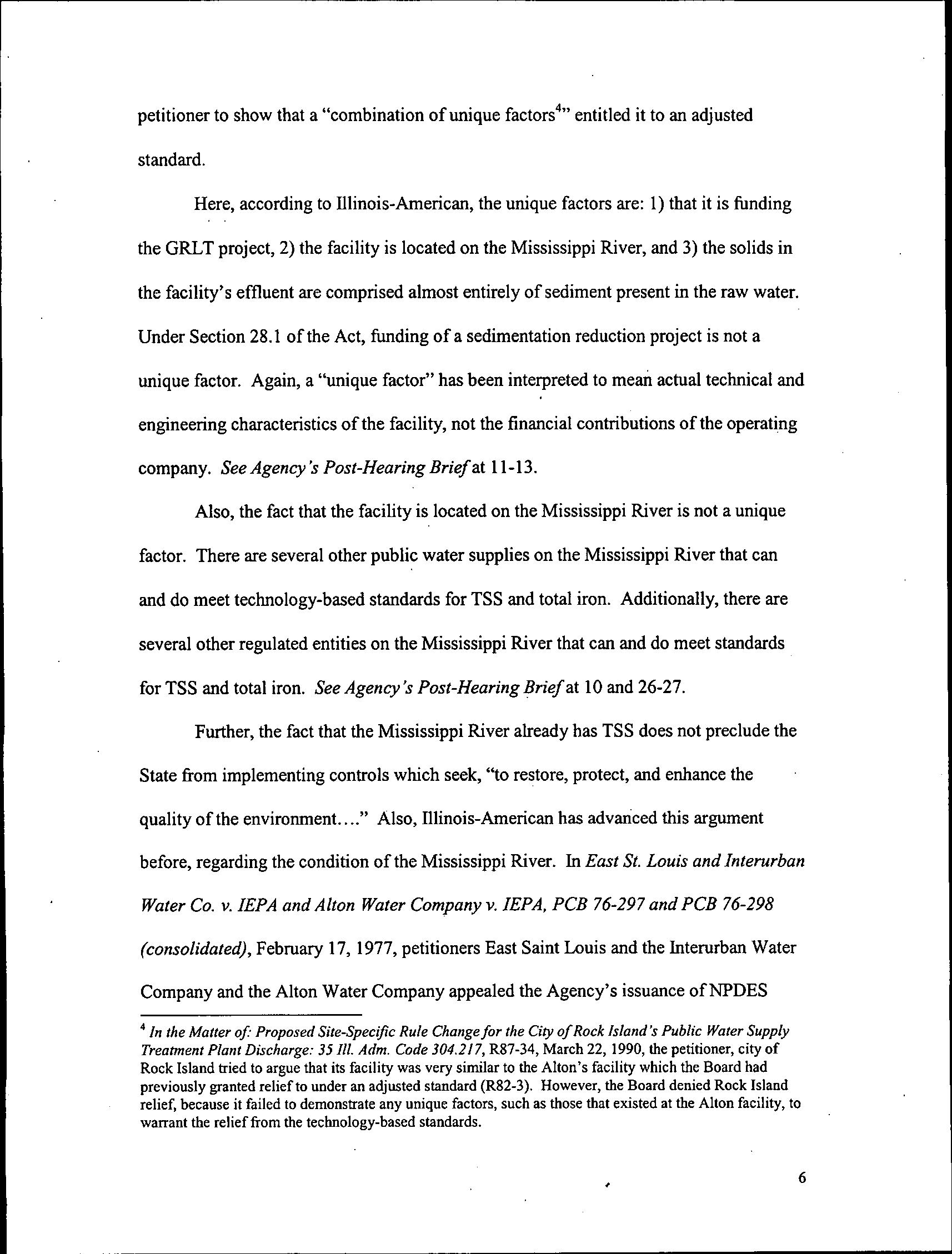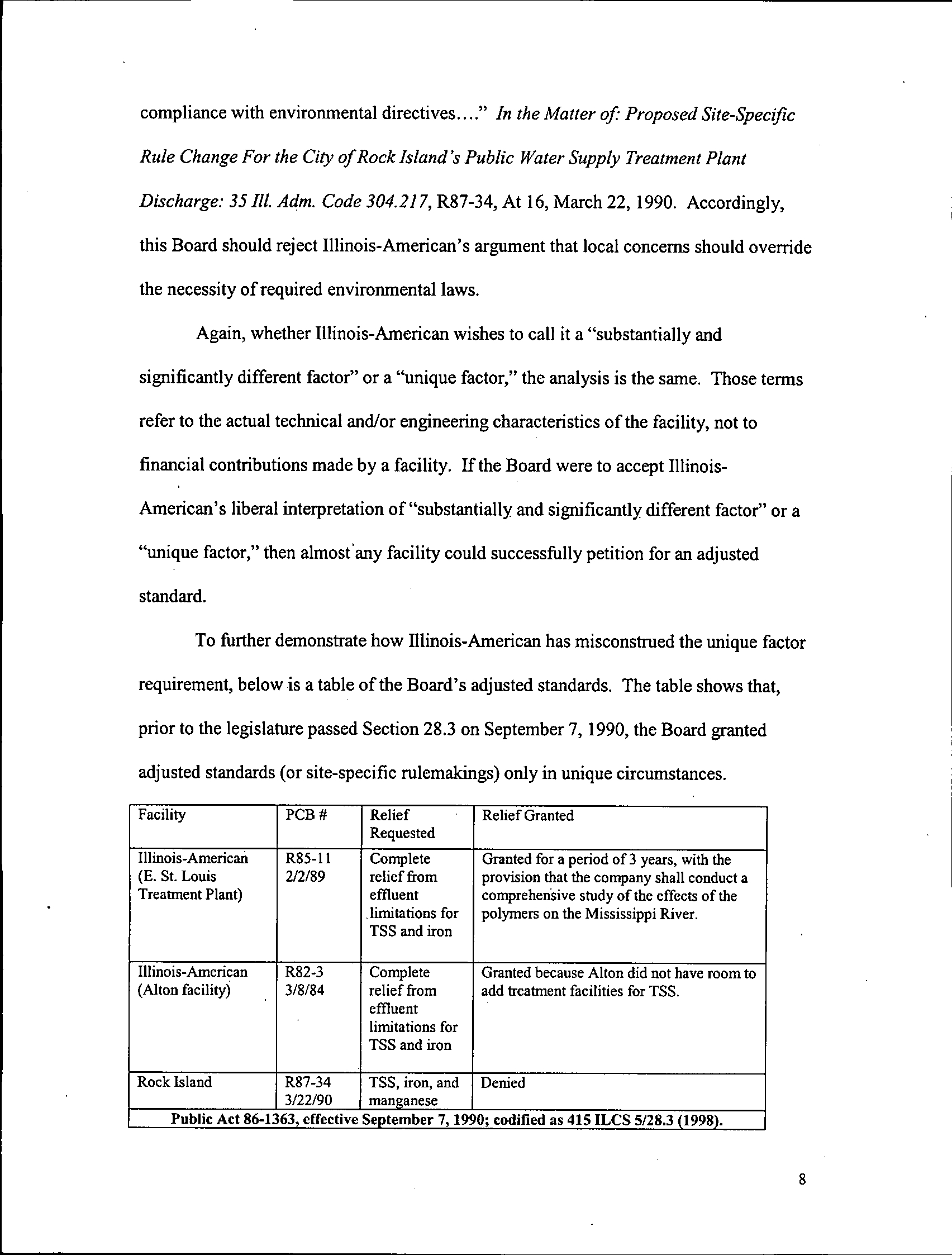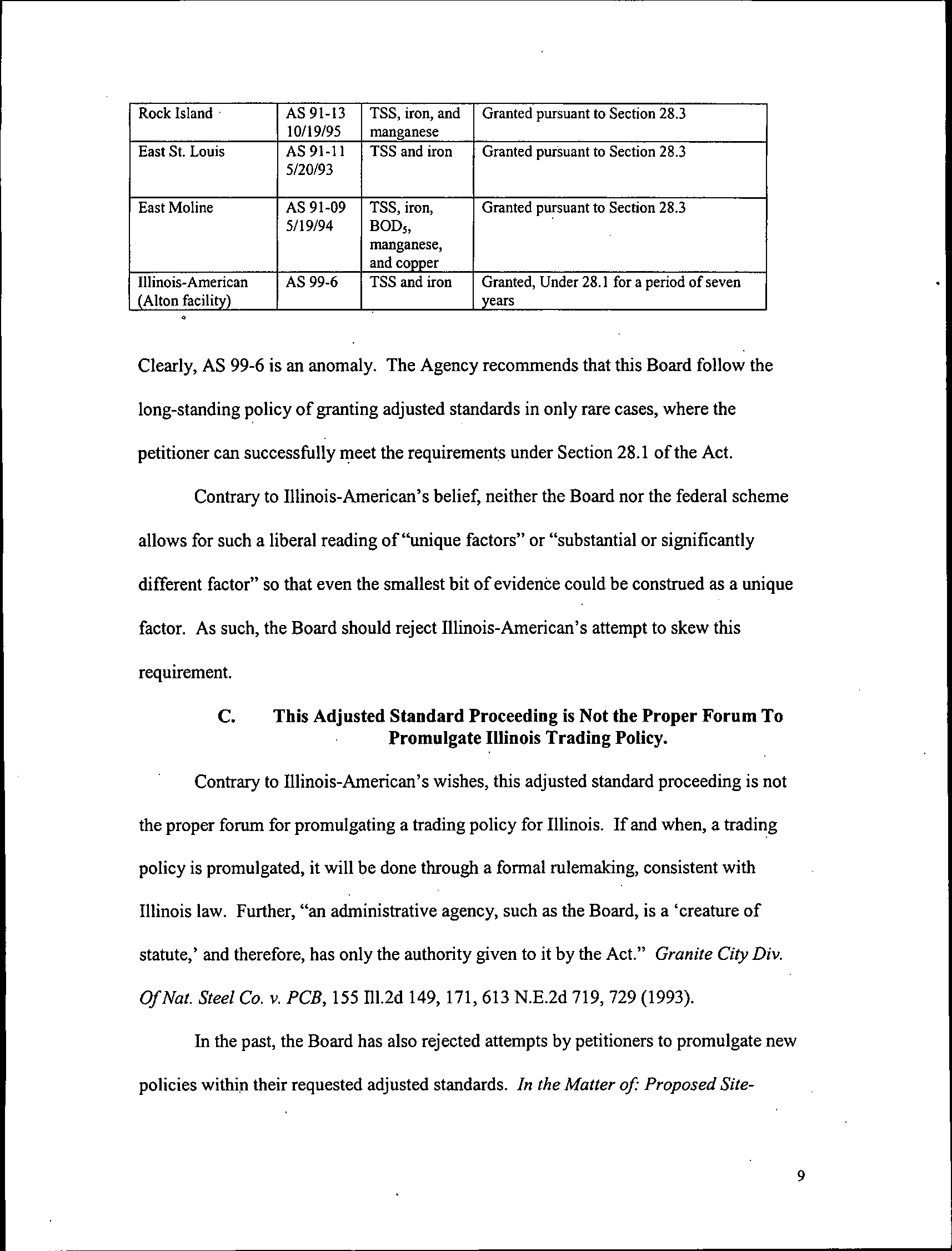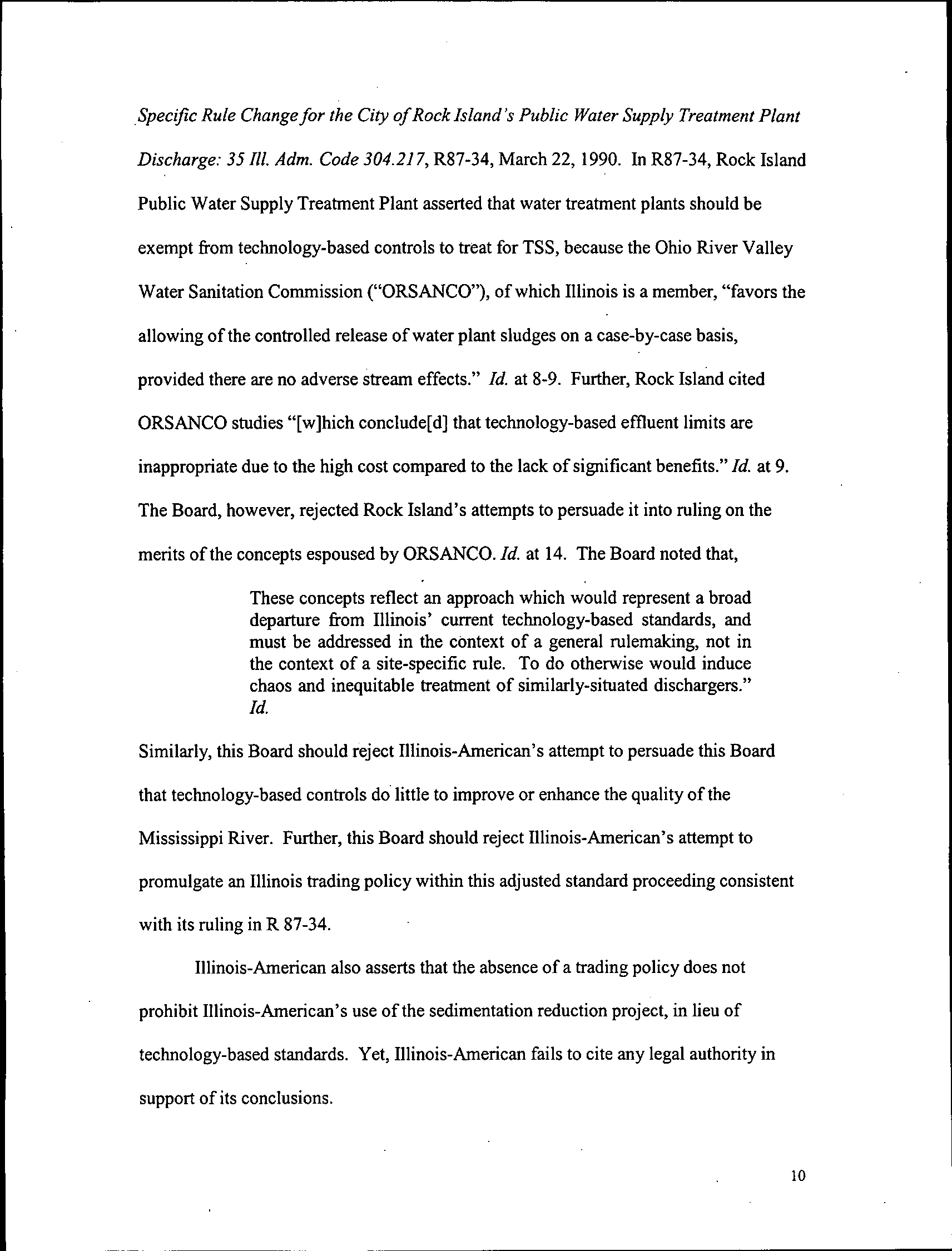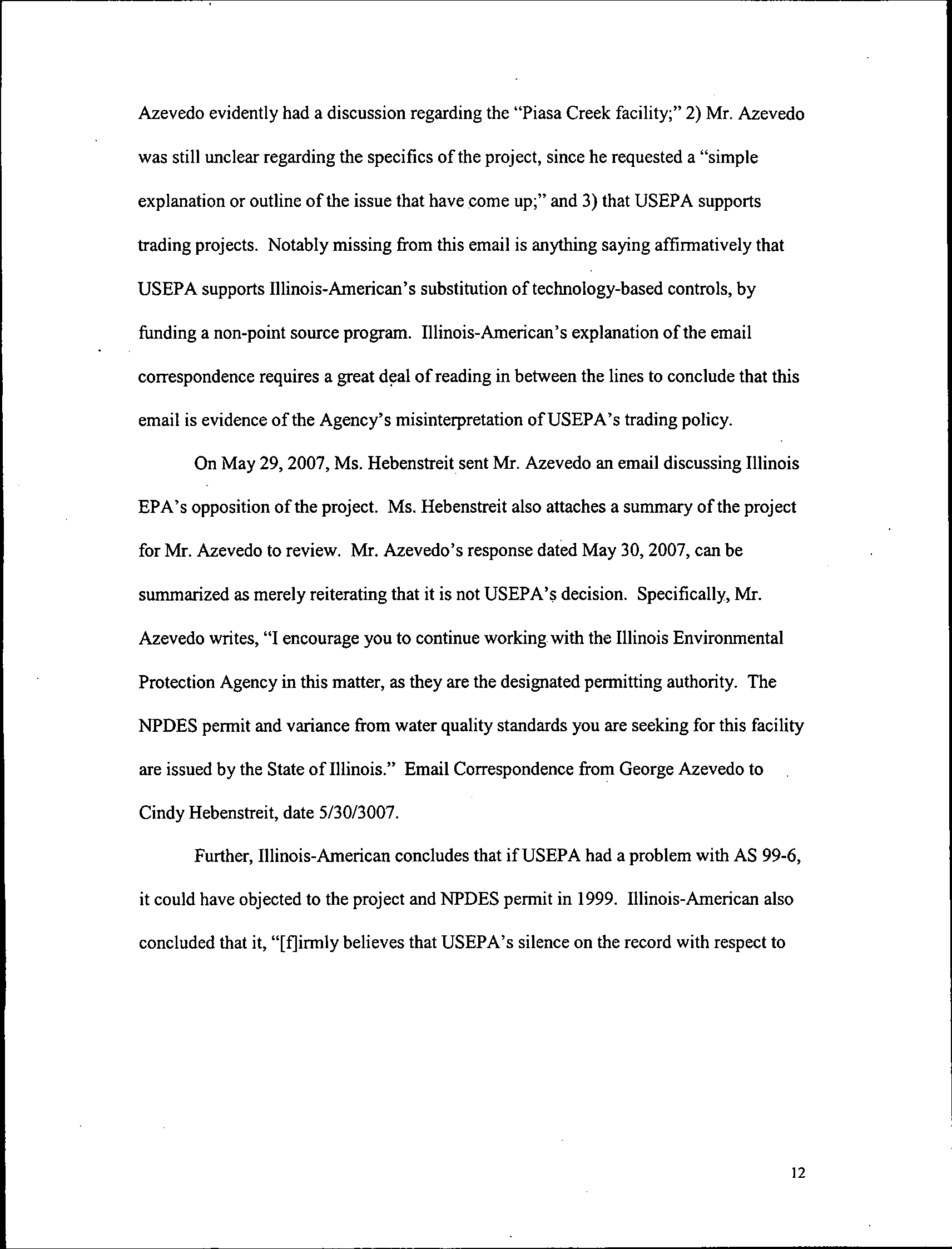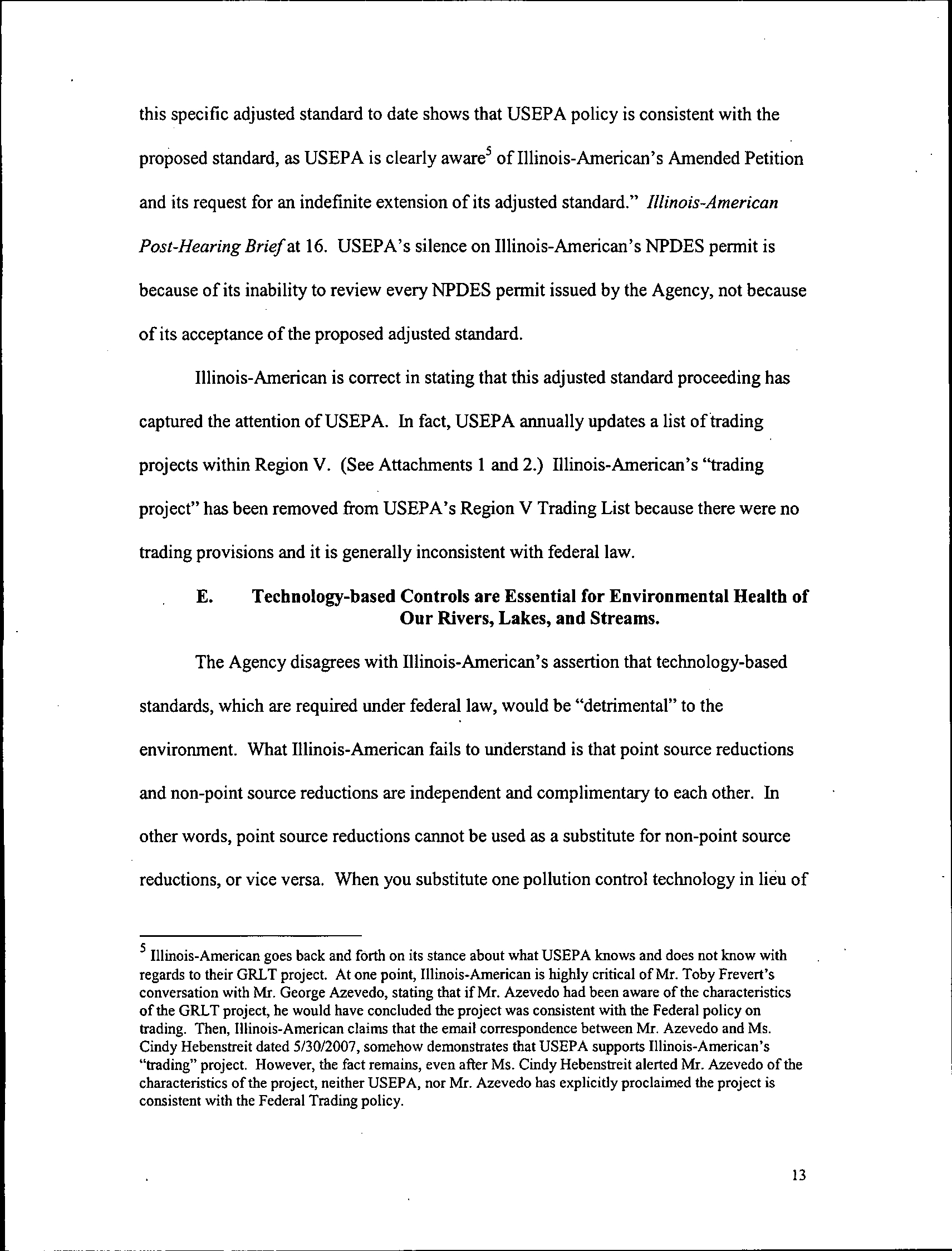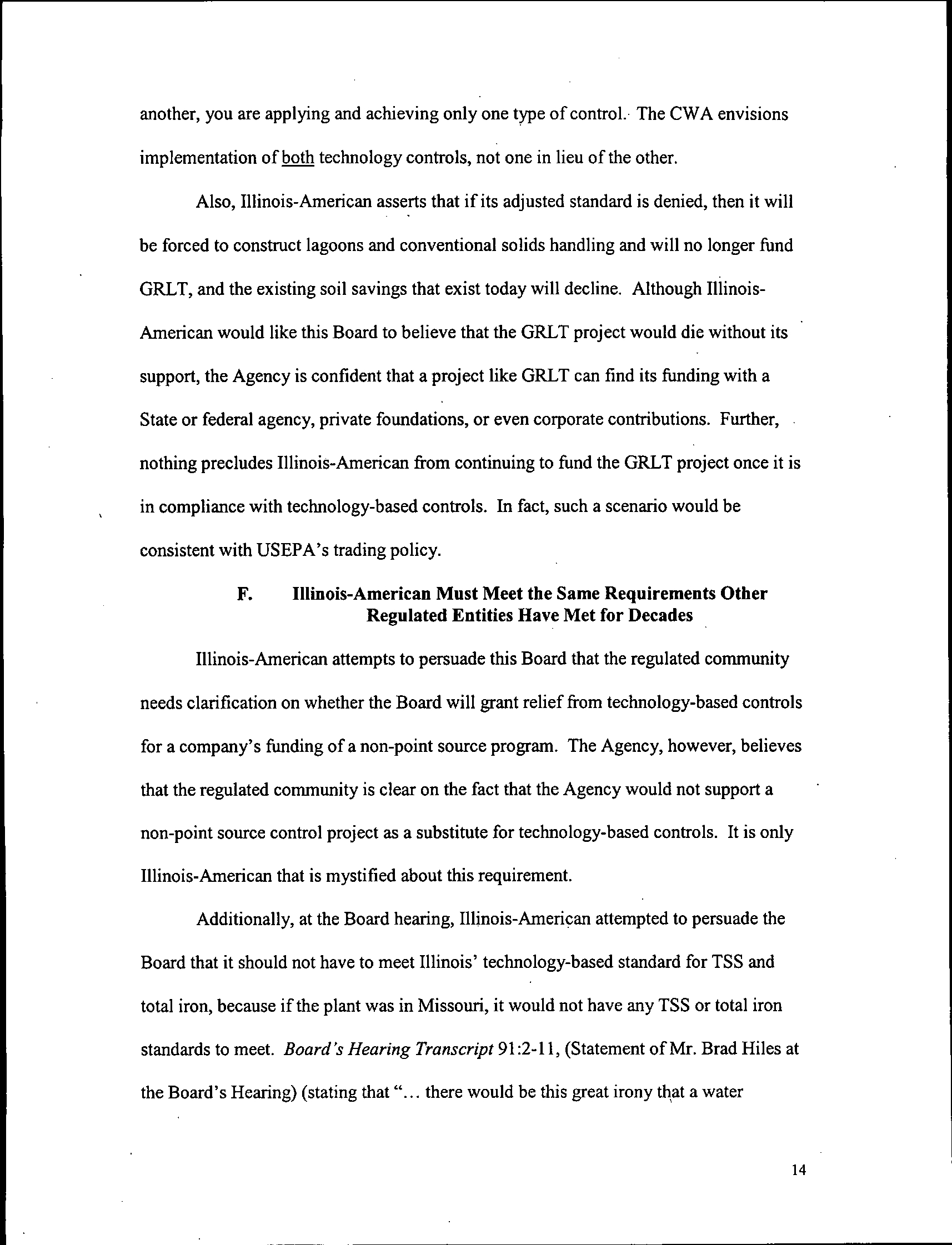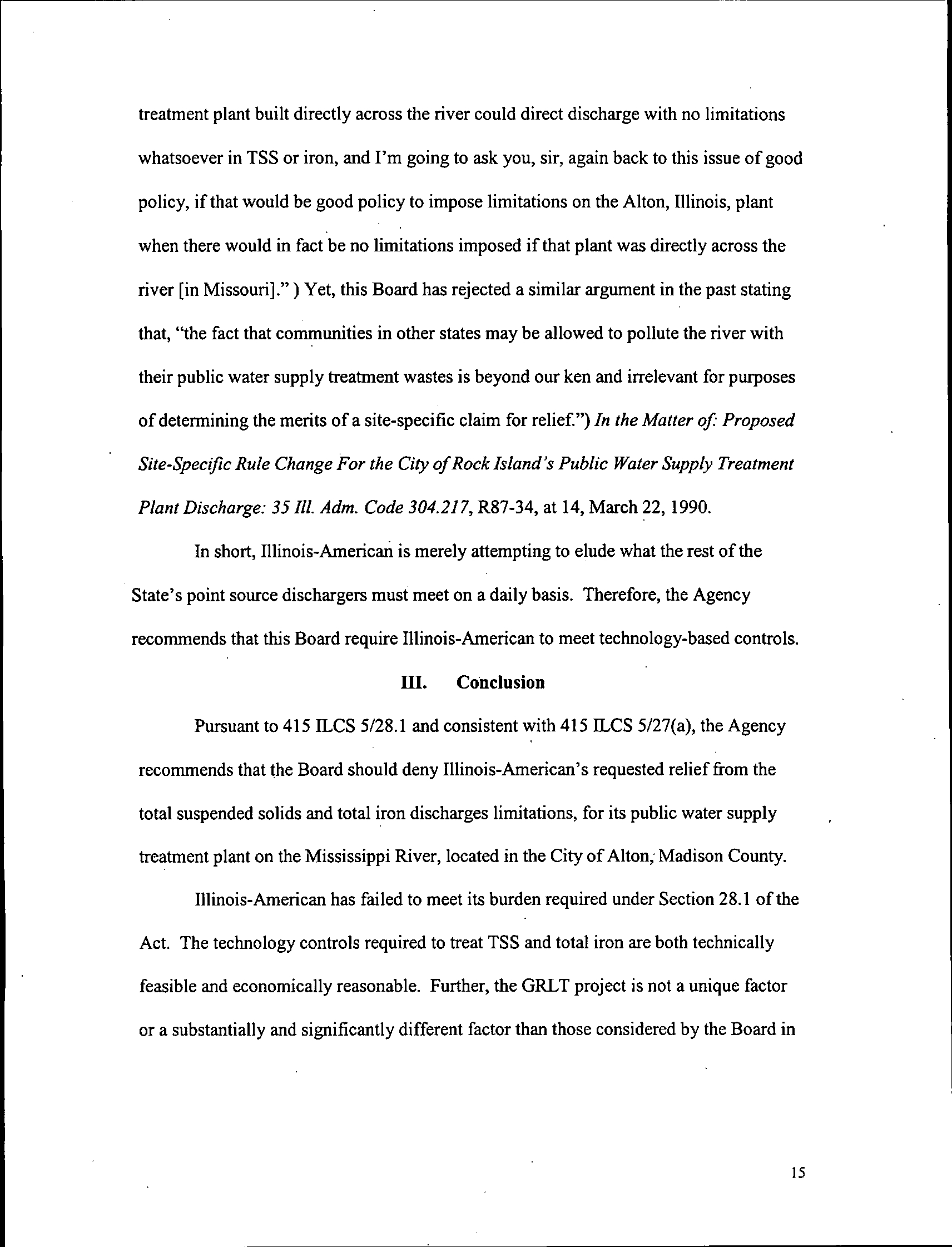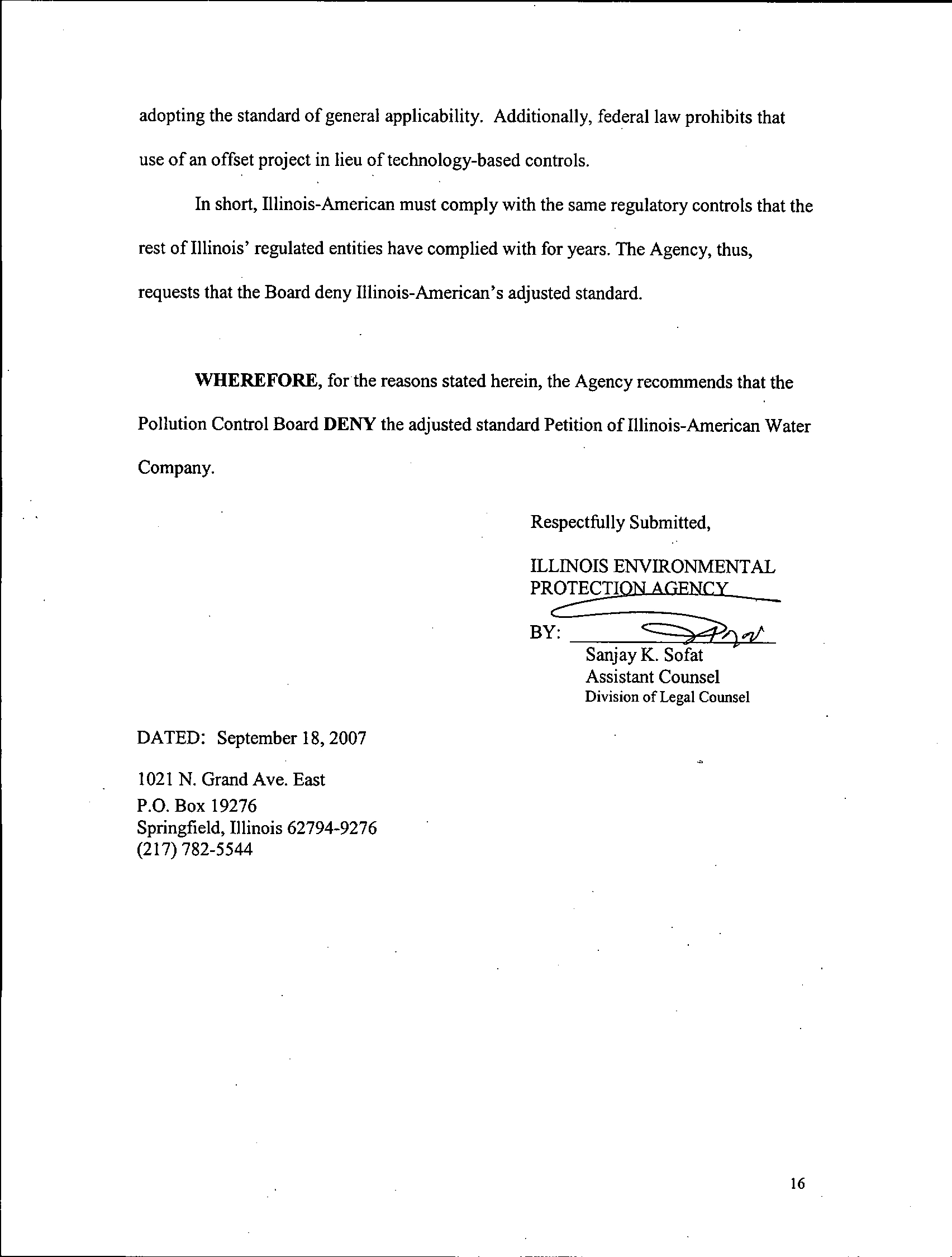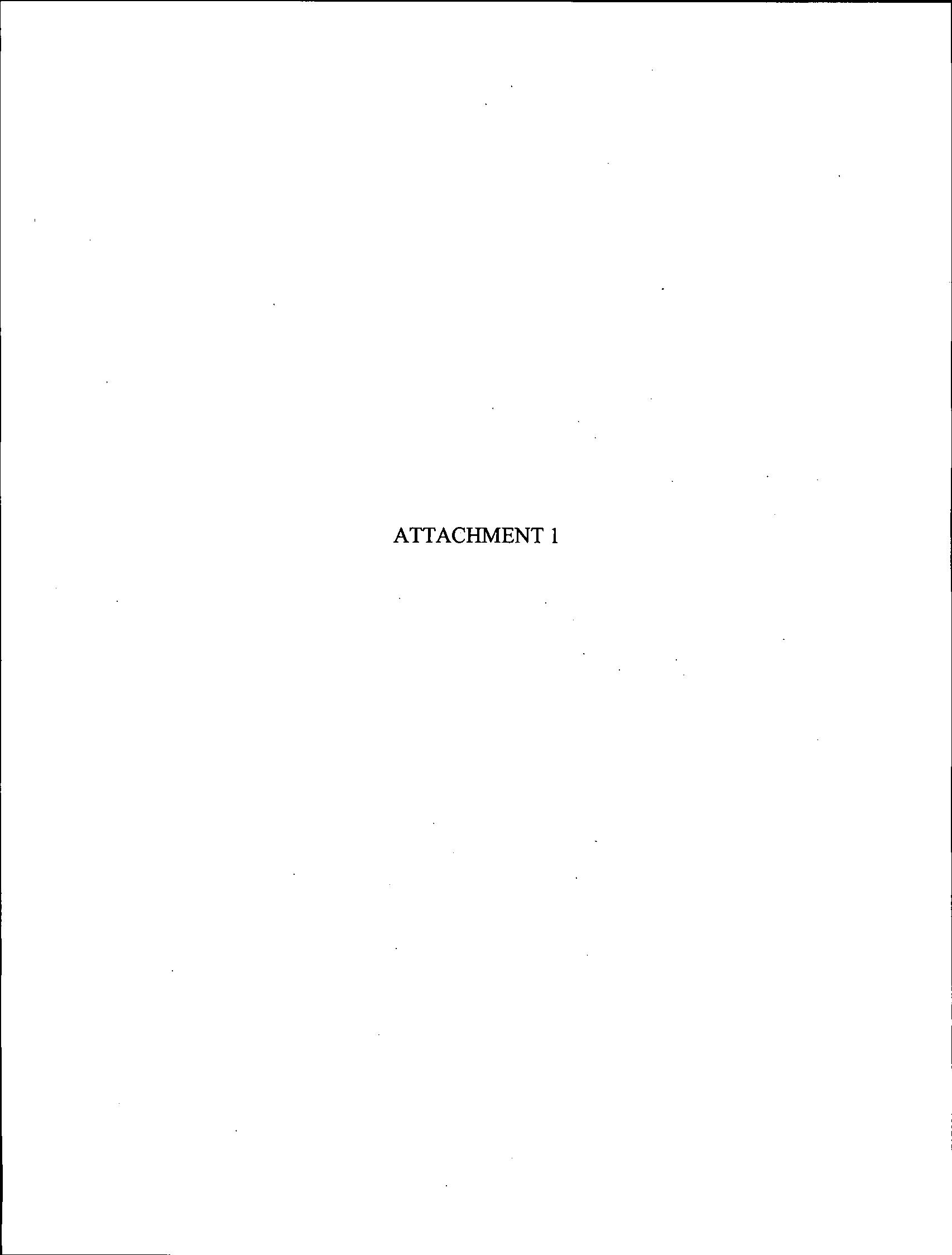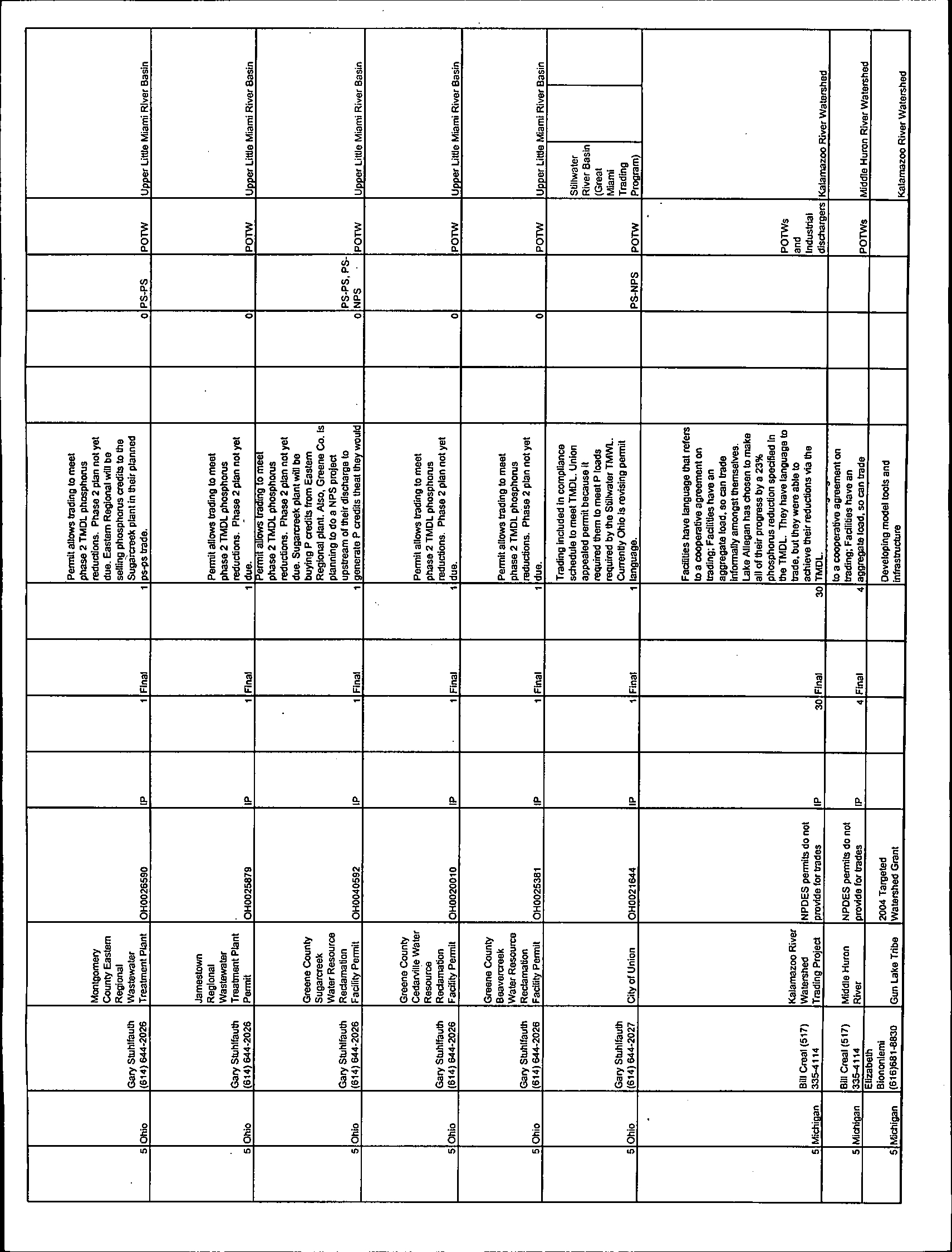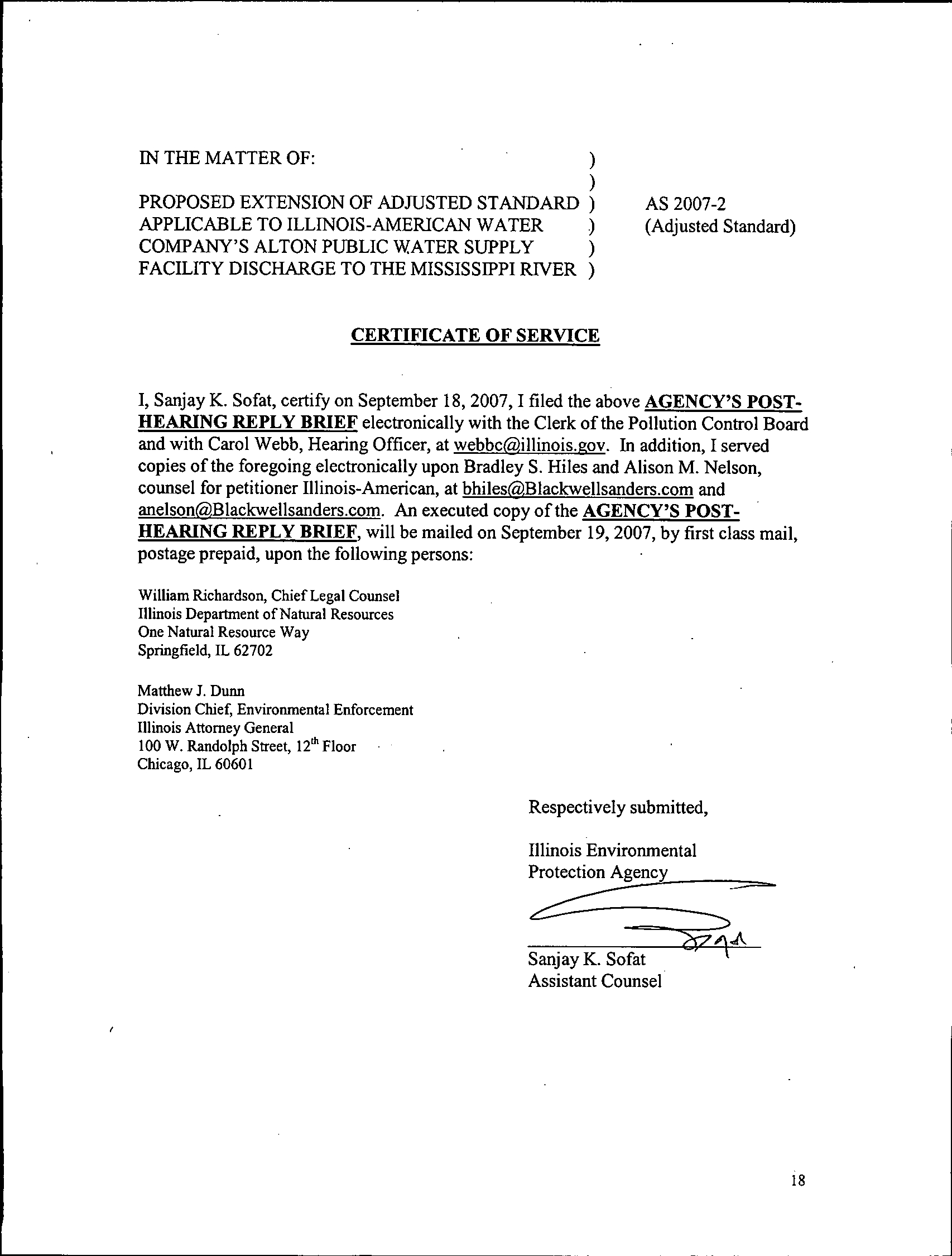BEFORE THE ILLINOIS POLLUTION CONTROL BOARD
IN THE MATTER OF:
)
)
PROPOSED EXTENSION OF ADJUSTED STANDARD )
APPLICABLE TO ILLINOIS-AMERICAN WATER
)
COMPANY'SALTON PUBLIC WATER SUPPLY
)
FACILITY DISCHARGE TO THE MISSISSIPPI
RNER )
NOTICE OF FILING
AS 2007-2
(Adjusted Standard)
PLEASE
TAkE NOTICE that on September 18, 2007, there was electronically
filed with the Office
of the Clerk ofthe Illinois Pollution Control Board of the State of
Illinois an original, executed copy of the AGENCY'SPOST-HEARING REPLY
BRIEF, a copy of which is herewith served upon you.
John Therriault, Assistant Clerk
Illinois Pollution Control Board
James
R.
Thompson Center
100 West Randolph Street, Suite. 11-500
Chicago, llIinois 60601
William Richardson, Chief Legal Counsel
Illinois Department
ofNatural Resources
One Natural Resource Way
Springfield, IL 62702
Carol Webb
Hearing Officer
llIinois Pollution Control Board
1021 North Grand Avenue East
P.O. Box 19274
Springfield, IL 62794-9274
Bradley
S. Hiles
Alison M. Nelson
Blackwell, Sanders, Peper,
&
Martin, LLP
720 Olive Street, 24" Floor
SI. Louis, Missouri 63101
Matthew J. Dunn
Division Chief, Environmental Enforcement
Illinois Attorney General
100 W. Randolph Street, 12" Floor
.Chicago,
IL 6060 I
ILLINOIS ENVIRONMENTAL PROTECTION AGENCY
By:
~-s-;i?;'
Sanjay
K.
Sofat
Assistant Counsel
Dated: September 18, 2007
Illinois Environmental Protection Agency
1021 North Grand Avenue East
Springfield, Illinois 62794-9276
(217) 782-5544
Electronic Filing, Received, Clerk's Office, September 18, 2007
BEFORE THE ILLINOIS POLLUTION CONTROL BOARD
IN THE MATTER OF:
)
)
PROPOSED EXTENSION OF ADmSTED STANDARD )
APPLICABLE TO ILLINOIS-AMERICAN WATER
)
COMPANY'S ALTON PUBLIC WATER SUPPLY
)
FACILITY DISCHARGE TO THE MISSISSIPPI RIVER )
AS 2007-2
(Adjusted Standard)
AGENCY'S
POST-HEARING REPLY BRIEF
NOW COMES the Respondent, Illinois Environmental Protection Agency
(UIllinois EPA"
or "Agency") by and through its attorney, Sanjay
K.
Sofat, Assistant
Counsel, hereby submits this reply to Illinois-American Water Company's(UIllinois-
American") post-hearing
brieffor an adjusted standard for its Alton Public Water Supply
facility.
In
its post-hearing brief, Illinois-American argues that there are two remaining
issues: 1) the success
of the Great River Land Trust's(uGRLT") project, and 2) whether
that GRLT project is a ''uniquefactor"
or a "substantially and significantly different
factor" than the Board considered in adopting the general effluent limitations. Despite
Illinois-American'scountless attempts to limit the Board'sreview to just the GRLT
project, the issue before the Board is whether Illinois-American has met its burden
of
proof as required under Section 28.1 of the Act. The Agency asserts that Illinois-
American has not met this statutory burden.
I.
Introduction
Illinois-American relies heavily upon the GRLT project to justify its requested
relief. The Agency does not dispute the significance
of the GRLT project, but takes issue
2
Electronic Filing, Received, Clerk's Office, September 18, 2007
with the purpose for which the project is being used. Illinois-American's use of the
GRLT project in lieu oftechnology-based controls is inconsistent with the language and
the goal
ofthe Clean Water Act ("CWA"). Illinois-American also relies heavily upon the
Agency'ssupport
of the project in the AS 99-6 proceeding. The Agency readily admits
that the Agency'srecommendation! in
AS 99-6 failed to correctly interpret and
implement the CWA. For the reasons stated below, the Agency recommends that this
Board deny Illinois-American'sadjusted standard with regards to its funding
of the
GRLT project in lieu oftechnology-based standards.
II.
Arguments
In
this brief, the Agency will address only the pertinent issues from llIinois-
American'sPost-Hearing Brief. The discussion below shows that Illinois-American is
not entitled
to an adjusted standard for merely funding a sedi,mentation reduction project.
Further, the Agency will show that Illinois-American has misconstrued the Board's
regulations to a point where practically any facility could
be granted an adjusted standard
from technology-based controls by funding a non-point source control project.
A. Tbe Success oftbe GRLT Project is Not a Relevant Factor
in
Granting tbis
Adjusted Standard.
Illinois-American attempts to persuade this Board to focus solely on the facts of
the GRLT project.
In
support, llIinois-American asserts that the GRLT project was the
I
Illinois-American believes that the Agency's support in AS 99-6 precludes
it
from changing its position in
the present proceeding. However, nothing precludes
an administrative agency from making reasonable
changes in the interpretation
of its regulations.
See Montana Power Co.
v.
EPA,
608 F.2d 334, 348 (9th
Cir. t979). Also, an agency is not bound
by its prior determinations, and their "decisions may not be set
aside merely because the agency has, on an earlier occasion reached a contrary
result"
International
Paper,
Inc.
v.
Bridges,
954 So.2d 321, 328 (2d Cit. 2007) (citing
Permian Basin AreaRate Cases,
390 U.S.
747,88 S.C!. 1344,20 L.Ed. 312 (1968)).
3
Electronic Filing, Received, Clerk's Office, September 18, 2007
essence of AS 99-6 proceeding, and should remain the essence ofthe present proceeding
as well.
Illinois-American's Post-Hearing Brief,
AS 07-02, September 10,2007 at 2
(Hereinafter
"IL-American
's
Post-Hearing brief').
The Agency objects to Illinois-
American'sattempt
to limit the Board'sreview ofthis adjusted standard to only the GRLT
project. Rather, the Board should review all the relevant facts in the present proceeding
to
determine if an adjusted standard is warranted under Section 28.1. There are two obvious
facts which Illinois-American cannot deny:
I) Illinois-American is subject to effluent
limitations just like any other facility in Illinois,2 and 2) Technology-based controls,
applicable
to Illinois-American, are both economically reasonable and technically feasible.
B.
The GRLT Project is Neither a "Unique Factor," Nor a "Substantially
and Significantly Different Factor"
Illinois-American argues that "no treatment" is the appropriate technology-based
control in this case and cites to the Agency'ssilence in the AS 99-6 proceeding. Illinois-
American also criticizes the Agency for not performing Best Professional Judgment
("BPJ")
to determine whether technology-based controls should apply to Illinois-
American'sAlton facility.
IL-American
's
BriefPost-Hearing Brief
at 6. The simple fact
is that the Agency'sdoes not have to perform a BPJ analysis
if a technology-based
standard for the pollutant ofconcerns exists in Part 304
3
of the Board regulations. Only
2 Illinois-American goes to great length to highlight the fact that Illinois-American'sAlton facility has not
had to meet the State'seffluent standards in over 100 years. Illinois-American then attempts to use this
fact'
as "evidence" that there are no effluent standards for the Alton area. However, the mere fact that Illinois-
American
is seeking this adjusted standard speaks to the fact that Illinois-American recognizes that it is still
required under law to meet Illinois' effluent limitations. Further, the fact that Illinois-American has been
granted relief in the past does not justify the need for continued relief. Instead, Illinois-American must .
meet the requirements under Section 28.1
of the Act to justify the need for its request for an adjusted
standard.
3 In 1972, the Board chose to adopt Part 304 standards, to avoid an overwhelming task of obtaining the
necessary case-by-case information to determine what limits are readily achievable in a given case.
See In
The Maller
Of: Effluent Criteria, R70-8; In The Maller Of: Water Quality Standards. R71-14; In The
4
Electronic Filing, Received, Clerk's Office, September 18, 2007
where no state or federal technology-based standard exists, does the Agency have to
perform a BPl analysis.
Further,
if this Board were to reject the Agency'sanalysis concerning BP1,
Illinois-American'sargument still cannot prevail. According to Illinois-American, the
GRLT project is a ''uniquefactor," under 40 C.F.R. 125.3(c)(2). Illinois-American
asserts that their consulting firm, ENSR, conducted a
BPl analysis in 1999.
In
1999,
ENSR determined through
BPl "the best practicable control technology (BPT) for the
proposed Alton replacement facility is no treatment
ofTSS in the discharge."
Illinois-
American's Post-Hearing
Brief
at 5. Illinois-American further concludes that since the
Agency'srecommendation in AS 99-6 raised no objection to ENSR's
BPl being no
treatment, then the Agency should not have an issue with this
BPl analysis now. lllinois-
American'sargument is flawed because the GRLT is not a "unique factor" and most
importantly
"no treatment" is an unacceptable BPl analysis under the CWA.
Additionally, Illinois-American's interpretation of a "unique factor" and the
Board'sinterpretation
of a "unique factor" are much different. Specifically, in
In the
Matter
of Proposed Site-Specific Rule Change for the City ofRock Island'sPublic Water
Supply Treatment Plant Discharge:
35
Ill. Adm. Code 304.217,
R87-34, at 14, March 22,
1990, the Board held that Rock Island, "[h]as not shown a comparable combination of
unique factors that would distinguish it from the host of Illinois communities which are
subject to Illinois' technology-based standards." Unlike Illinois-American's liberal
interpretation
of a unique factor, the Board adopted an interpretation which required
Malter Of Waler Quality Standards Revisions For Interstate Waters (SWB-14),
R71-20, slip op. at I,
January 6, 1972.
5
Electronic Filing, Received, Clerk's Office, September 18, 2007
petitioner to show that a "combination of unique factors
4
"
entitled it to an adjusted
standard.
Here, according to illinois-American, the unique factors are:
1) that it is funding
the GRLT project, 2) the facility is located on the Mississippi River, and 3) the solids in
the facility's effluent are comprised almost entirely
of sediment present
in
the raw water.
Under Section 28.1
of the Act, funding of a sedimentation reduction project is not a
unique factor. Again, a "unique factor" has been interpreted to mean actual technical and
engineering characteristics
ofthe facility, not the financial contributions of the operating
company.
See Agency's Post-Hearing
Brief
at 11-13.
Also, the fact that the facility is located on the Mississippi River is not a unique
factor. There are several other public water supplies on the Mississippi River that can
and do meet technology-based standards for TSS and total iron. Additional1y, there are
several other regulated entities on the Mississippi River that can and do meet standards
for TSS and total iron.
See Agency'sPost-Hearing
Briefat
10 and 26-27.
Further, the fact that the Mississippi River already has TSS does not preclude the
State from implementing controls which seek, ''torestore, protect, and enhance the
quality
of the environment. ..." Also, llIinois-American has advanced this argument
before, regarding the condition
of the Mississippi River. In
East St. Louis and Interurban
Water
Co. v. IEPA and Alton Water Company v. IEPA, PCB
76-297
and PCB 76-298
(consolidated),
February 17, 1977, petitioners East Saint Louis and the Interurban Water
Company and the Alton Water Company appealed the Agency'sissuance
ofNPDES
4 In the Matter of" Proposed Site-Specific Rule Change for the City ofRock Island's Public Water Supply
Treatment Plant Discharge:
35 III.
Adm. Code 304.217,
R87-34, March 22, 1990, the petitioner, city of
Rock Island tried to argue that its facility was very similar to the Alton'sfacility which the Board had
previously granted reliefto under an adjusted standard (R82-3). However, the Board denied Rock Island
relief, because it failed to demonstrate any unique factors, such as those that existed at the Alton facility, to
warrant the relieffrom the technology-based standards.
,
6
Electronic Filing, Received, Clerk's Office, September 18, 2007
permits with TSS limitations, consistent with the State'seffluent limitations. Petitioners
asserted that since TSS was already in the Mississippi River, they should not
be required
to clean what is already in the water. The Board held that the background concentrations
in the Mississippi River do not preclude a facility from using technology-based controls
to meet TSS standards. Specifically, the Board noted that:
401(b) [now 35 Ill. Adm. Code 304.106] refers to "users"
ofwater.
However, in the present case Petitioners do not "use" waters, as for
example, would a facility which uses water for cooling purposes
and then discharges it. Petitioners' herein are consumers
of the
water; the water itself is a commodity which they market. The
Board finds that the exception granted in Rule 40 I(b) was not
intended
to apply to this type of situation.
[d.
at 3.
Following this ruling, both East Saint Louis and Interurban Water Company and the
Alton Water company pursued site-specific rulemakings.
Here, Illinois-American does not present any compelling evidence
to show why
this Board should ignore its long-standing policy
of granting adjusted standards for only
those facilities with unique technical or engineering characteristics. Rather, Illinois-
American'sonly argument is that the Alton community does not support the building
of
treatment control technologies. Some members of the Alton community have voiced
opposition to the Agency'sRecommendation because the building oftechnology-based
controls would increase traffic along the highway, interfere with the nearby bike path,
and be
an unsightly addition to their community. In the past, the Board has also dealt
with a similar situation in Rock Island, where the community and the public water supply
argued that the building Of technology-based controls would interfere with a recreational
park. However, the Board rejected that argument, stating that, "equally important, as a
matter ofpolicy, we cannot weigh the relative value of this "park" against the value of
7
Electronic Filing, Received, Clerk's Office, September 18, 2007
compliance with environmental directives...."
In the Matter of Proposed Site-Specific
Rule Change For the City
ofRock Island's Public Water Supply Treatment Plant
Discharge:
35
Ill. Adm. Code 304.217,
R87-34, At 16, March 22, 1990. Accordingly,
this Board should reject IlIinois-American'sargument that local concerns should override
the necessity
ofrequired environrnentallaws.
Again, whether Illinois-American wishes to call it a "substantially and
significantly different factor"
or a "unique factor," the analysis is the same. Those terms
refer to the actual technical and/or engineering characteristics
of the facility, not to
financial contributions made
by a facility. If the Board were to accept IlIinois-
American's liberal interpretation
of "substantially and significantly different factor" or a
"unique factor," then aImost'anyfacility could successfully petition for an adjusted
standard.
To further demonstrate how Illinois-American has misconstrued the unique factor
requirement, below is a table
of the Board'sadjusted standards. The table shows that,
prior to the legislature passed Section 28.3 on September
7,1990, the Board granted
adjusted standards (or site-specific rulemakings) only in unique circumstances.
Facility
PCB #
Relief
Relief Granted
Requested
Illinois-American
R85-11
Complete
Granted for a period
of 3 years, with the
(E.
SI. Louis
2/2/89
relief from
provision that the company shall conduct a
Treatment Plant)
effluent
comprehenSive study
of the effects of the
.limitations for
polymers on the Mississippi River.
TSS and iron
Illinois-American
R82-3
Complete
Granted because Alton did not have room to
(Aiton facility)
3/8/84
relief from
add treatment facilities for TSS.
effluent
limitations for
TSS and iron
Rock Island
R87-34
TSS, iron, and
Denied
3/22/90
man2;anese
Public Act 86-1363, effective September 7, 1990; codified as 415 ILeS 5/28.3 (1998).
8
Electronic Filing, Received, Clerk's Office, September 18, 2007
Rock Island .
AS 91-13
TSS, iron, and
Granted pursuant to Section 28.3
10/19/95
manganese
East St. Louis
AS 91-11
TSS and iron
Granted pursuant to Section 28.3
5/20/93
East Moline
AS 91-09
TSS, iron,
Granted pursuant to Section 28.3
5/19/94
BOD"
manganese,
and copper
Illinois-American
AS 99-6
TSS and iron
Granted, Under 28.1 for a period of seven
(Alton facility)
years
Clearly, AS 99-6 is an anomaly. The Agency recommends that this Board follow the
long-standing policy
of granting adjusted standards in only rare cases, where the
petitioner can successfully meet the requirements under Section 28.1 ofthe Act.
Contrary to Illinois-American'sbelief, neither the Board nor the federal scheme
allows for such a liberal reading
of "unique factors" or "substantial or significantly
different factor" so that even the smallest bit
of evidence could be construed as a unique
factor. As such, the Board should reject Illinois-American'sattempt to skew this
requirement.
C.
This Adjusted Standard Proceeding is Not the Proper Forum To
Promulgate IUinois Trading Policy.
Contrary to llIinois-American'swishes, this adjusted standard proceeding is not
the proper forum for promulgating a trading policy for Illinois. If and when, a trading
policy is promulgated, it will be done through a fonual rulemaking, consistent with
Illinois law. Further, "an administrative agency, such as the Board, is a 'creature
of
statute,' and therefore, has only the authority given to it by the Act."
Granite City Div.
DfNat. Steel
Co.
v.
PCB,
155 m.2d 149, 171, 613 N.E.2d 719,729 (1993).
In the past, the Board has also rejected attempts by petitioners to promulgate new
policies within their requested adjusted standards.
In the Matter of Proposed Site-
9
Electronic Filing, Received, Clerk's Office, September 18, 2007
Specific Rule Change for the City ofRock Island's Public Water Supply Treatment Plant
Discharge:
35
Ill. Adm. Code 304.217,
R87-34, March 22, 1990.
In
R87-34, Rock Island
Public Water Supply Treatment Plant asserted that water treatment plants should
be
exempt from technology-based controls to treat for TSS, because the Ohio River Valley
Water Sanitation Commission ("ORSANCO"),
of which Illinois is a member, "favors the
allowing
of the controlled release of water plant sludges on a case-by-case basis,
provided there are no adverse stream effects."
Id.
at 8-9. Further, Rock Island cited
ORSANCO studies
"[w]hich concluderd] that technology-based effluent limits are
inappropriate due to the high cost compared to the lack of significant benefits."
/d.
at 9.
The Board, however, rejected Rock Island'sattempts to persuade it into ruling on the
merits
ofthe concepts espoused by ORSANCO.
/d.
at 14. The Board noted that,
These concepts reflect an approach which would represent a broad
departure from Illinois' current technology-based standards, and
must be addressed in the ctmtext
of a general rulemaking, not in
the context of a site-specific rule. To do otherwise would induce
chaos and inequitable treatment of similarly-situated dischargers."
Id.
Similarly, this Board should reject Illinois-American'sattempt to persuade this Board
that technology-based controls do little to improve or enhance the quality
of the
Mississippi River. Further, this Board should reject Illinois-American'sattempt to
promulgate
an Illinois trading policy within this adjusted standard proceeding consistent
with its ruling in R 87-34.
Illinois-American also asserts that the absence
of a trading policy does not
prohibit Illinois-American's use ofthe sedimentation reduction project, in lieu of
technology-based standards. Yet, Illinois-American fails to cite any legal authority in
support
of its conclusions.
10
Electronic Filing, Received, Clerk's Office, September 18, 2007
-------_
...
_- _._-----
Illinois-American cites AS 91-9 and AS 91-13 as justification that this Board has
before approved an offset project in lieu
of technology-based standards. Illinois-
American asserts these adjusted standards were granted indefinitely and with more
lenient conditions than IlIinois-American'soffset project. However, Illinois-American
conveniently glazes over the fact that these adjusted standards were granted pursuant to a
special provision under Section 28.3
of the Act (See Table on page 8-9). Section 28.3 of
the Act, which was signed into law on September 7, 1990, establishes provisions whereby
certain petitioners may request
of the Board an adjustment of the standards otherwise
applicable to direct discharge
of waste solids to the Mississippi or Ohio Rivers. Public
Act 86-1363, effective September
7,1990; codified as 415 lLCS 5/28.3 (1998).
However, the legislature limited the applicability
of Section 28.3 to only adjusted
standard petitioned before January 1,1992. Therefore, it is clear that the legislature did
not intend for relief under this Section beyond 1992. It is well-settled that administrative
agencies are limited to the rule-making power granted them by the legislature.
Peabody
Coal
Co. v. Illinois Pollution Control Bd.,
36 IlI.App.3d 5, 344 N.E. 2d 279,282 (5
th
Dist., 1976) (Citing
Ruby Chevrolet, Inc. v. Department ofRevenue,
6 Hl.2d 147, 126
N.E.2d 617 (1955».
D.
Illinois-American's Conclusions Are Not Supported by Mr.
Azevedo's
Email Correspondence
Illinois-American asserts that Mr. George Azevedo'semail correspondence with
Ms. Cindy Hebenstreit is "evidence" that the Agency has misinterpreted USEPA policy
on trading. One email dated February 27, 2007 from Mr. Azevedo to Ms. Hebenstreit
merely points to information regarding
USEPA's policy on trading. The only relevant
information that can be gleaned from this email is that, 1) Ms. Hebenstreit and Mr.
11
Electronic Filing, Received, Clerk's Office, September 18, 2007
Azevedo evidently had a discussion regarding the "Piasa Creek facility;" 2) Mr. Azevedo
was still unclear regarding the specifics
ofthe project, since he requested a "simple
explanation or outline
of the issue that have come up;" and 3) that USEPA supports
trading projects. Notably missing from this email is anything saying affirmatively that
USEPA supports IIlinois-American'ssubstitution
of technology-based controls, by
funding a non-point source program. IIlinois-American's explanation of the email
correspondence requires a great
d~al
ofreading in between the lines to conclude that this
email is evidence
of the Agency'smisinterpretation ofUSEPA's trading policy.
On May 29, 2007, Ms. Hebenstreit sent Mr. Azevedo an email discussing Illinois
EPA'sopposition of the project. Ms. Hebenstreit also attaches a summary of the project
for Mr. Azevedo to review. Mr. Azevedo'sresponse dated May 30, 2007, can
be
summarized as merely reiterating that it is not USEPA's decision. Specifically, Mr.
Azevedo writes, "I encourage you to continue working with the Illinois Environmental
Protection Agency in this matter, as they are the designated permitting authority. The
NPDES permit and variance from water quality standards you are seeking for this facility
are issued by the State
of Illinois." Email Correspondence from George Azevedo to
Cindy Hebenstreit, date 5/30/3007.
Further, Illinois-American concludes that
ifUSEPA had a problem with AS 99-6,
it could have objected to the project and NPDES permit in 1999. Illinois-American also
concluded that it, "[f]irmly believes that
USEPA'ssilence on the record with respect to
12
Electronic Filing, Received, Clerk's Office, September 18, 2007
this specific adjusted standard to date shows that USEPA policy is consistent with the
proposed standard, as USEPA is clearly aware
5
of Illinois-American's Amended Petition
and its request for an indefinite extension
of its adjusted standard."
Illinois-American
Post-Hearing Brie/at
16.
USEPA's silence on IIIinois-American'sNPDES permit is
because
of its inability to review every NPDES permit issued by the Agency, not because
of its acceptance of the proposed adjusted standard.
Illinois-American is correct in stating that this adjusted standard proceeding has
captured the attention
of USEPA.
In
fact, USEPA annually updates a list oftrading
projects within Region V. (See Attachments I and 2.) Illinois-American's"trading
project" has been removed from USEPA'sRegion V Trading List because there were no
trading provisions and it is generally inconsistent with federal law.
E.
Technology-based Controls are Essential for Environmental Health of
Our Rivers, Lakes, and Streams.
The Agency disagrees with Illinois-American'sassertion that technology-based
standards, which are required under federal law, would be "detrimental" to the
environment. What Illinois-American fails to understand is that point source reductions
and non-point source reductions are independent and complimentary to each other.
In
other words, point source reductions cannot be used as a substitute for non-point source
reductions,
or vice versa. When you substitute one pollution control technology in lieu of
5 Illinois-American goes back and forth on its stance about what USEPA knows and does not know with
regards to their GRLT project. At one point, Illinois-American is highly critical
of Mr. Toby Frevert's
conversation with
Mr.
George Azevedo, stating that ifMr. Azevedo had been aware of the characteristics
of the GRLT project, he would have concluded the project was consistent with the Federal policy on
trading. Then, Illinois-American claims that the email correspondence between
Mr.
Azevedo and Ms.
Cindy Hebenstreit dated 5/30/2007, somehow demonstrates that USEPA supports Illinois-American's
"trading" project. However, the fact remains, even after Ms. Cindy Hebenstreit alerted
Mr.
Azevedo of the
characteristics
of the project, neither USEPA, nor Mr. Azevedo has explicitly proclaimed the project is
consistent with the Federal Trading policy.
13
Electronic Filing, Received, Clerk's Office, September 18, 2007
another, you are applying and achieving only one type of control. The CWA envisions
implementation
of both technology controls, not one in lieu of the other.
Also, Illinois-American asserts that
if its adjusted standard is denied, then it will
be forced to construct lagoons and conventional solids handling and will no longer fund
GRLT, and the existing soil savings that exist today will decline. Although Illinois-
American would like this Board to believe that the GRLT project would die without its
support, the Agency is confident that a project like GRLT can find its funding with a
State or federal agency, private foundations, or even corporate contributions. Further,
nothing precludes Illinois-American from continuing to fund the GRLT project once it is
in compliance with technology-based controls.
In
fact, such a scenario would be
consistent with USEPA's trading policy.
F.
Illinois-American Must Meet the Same Requirements Other
Regulated Entities Have Met for Decades
Illinois-American attempts to persuade this Board that the regulated community
needs clarification on whether the Board will grant relief from technology-based controls
for a company'sfunding
of a non-point source program. The Agency, however, believes
that the regulated community is clear on the fact that the Agency would not support a
non-point source control project as a substitute for technology-based controls.
It
is only
Illinois-American that is mystified about this requirement.
Additionally, at the Board hearing, Illinois-American attempted to persuade the
Board that it should not have to meet Illinois' technology-based standard for TSS and
total iron, because if the plant was in Missouri, it would not have any TSS or total iron
standards to meet.
Board'sHearing Transcript
91:2-11, (Statement ofMr. Brad Hiles at
the Board'sHearing) (stating that"... there would be this great irony that a water
14
Electronic Filing, Received, Clerk's Office, September 18, 2007
treatment plant built directly across the river could direct discharge with no limitations
whatsoever in TSS or iron, and
I'm going to ask you, sir, again back to this issue of good
policy,
if that would be good policy to impose limitations on the Alton, Illinois, plant
when there would in fact be no limitations imposed
if that plant was directly across the
river [in Missouri].") Yet, this Board has rejected a similar argument in the past stating
that, "the fact that communities
in
other states may be allowed to pollute the river with
their public water supply treatment wastes is beyond our ken and irrelevant for purposes
of determining the merits of a site-specific claim for relief.")
In the Matter of Proposed
Site-Specific Rule Change For the City
ofRock Island's Public Water Supply Treatment
Plant Discharge:
35
Ill. Adm. Code 304.217,
R87-34, at 14, March 22,1990.
In
short, Illinois-American is merely attempting to elude what the rest of the
State'spoint source dischargers must meet on a daily basis. Therefore, the Agency
recommends that this Board require Illinois-American to meet technology-based controls.
llI.
Conclusion
Pursuant to 415 ILCS 5/28.1 and consistent with 415 ILCS 5/27(a), the Agency
recommends that the Board should deny Illinois-American'srequested relief from the
total suspended solids and total iron discharges limitations, for its public water supply
treatment plant on the Mississippi River, located in the City
of Alton, Madison County.
Illinois-American has failed to meet its burden required under Section 28.1
of the
Act. The technology controls required to treat TSS and total iron are both technically
feasible and economically reasonable. Further, the GRLT project is not a unique factor
or a substantially and significantly different factor than those considered by the Board in
15
Electronic Filing, Received, Clerk's Office, September 18, 2007
adopting the standard of general applicability. Additionally, federal law prohibits that
use
of an offset project in lieu of technology-based controls.
In short, Illinois-American must comply with the same regulatory controls that the
rest
of Illinois' regulated entities have complied with for years. The Agency, thus,
requests that the Board deny Illinois-American'sadjusted standard.
WHEREFORE,
for the reasons stated herein, the Agency recommends that the
Pollution Control Board
DENY
the adjusted standard Petition of Illinois-American Water
Company.
Respectfully Submitted,
ILLINOIS ENVIRONMENTAL
::~TJ:S;:;
Sanjay
K.
Sofat
Assistant Counsel
Division of Legal Counsel
DATED: September 18, 2007
1021
N. Grand Ave. East
P.O. Box 19276
Springfield, Illinois 62794-9276
(217) 782-5544
16
Electronic Filing, Received, Clerk's Office, September 18, 2007
--------------------------------
STATE OF ILLINOIS
COUNTY OF SANGAMON
)
)
)
SS
AFFIDAVIT OF TOBY FREVERT
I,
Toby Frevert, after being first duly sworn upon my oath, do depose and say as
follows:
I.
I am employed by the Illinois Environmental Protection Agency, as
the Manager
ofthe Division ofthe Water Pollution Control.
2.
I received an email from Mr. George Azevedo, the NPDES Nutrients
and Water Quality Trading Coordinator for USEPA Region
5, on
August 23, 2007.
3.
The email attached to the Agency'sPost-Hearing Reply Briefas
Attachment I is a true and accurate copy
ofthat email.
4.
The spreadsheet attached to the Agency'sPost-Hearing Reply Briefas
Attachment 2 is a true and accurate copy
ofthat spreadsheet.
Further, Affiant sayeth not.
Subscribed and sworn to before me, a notary public in and for said County and
.State, this
~ay
of September 2007.
.
Notary Public
My Commission Expires:
17
Electronic Filing, Received, Clerk's Office, September 18, 2007
ATTACHMENT 1
Electronic Filing, Received, Clerk's Office, September 18, 2007
From:
To:
Date:
SUbject:
FYI
Toby Frevert
Sofat, Sanjay
9/11/20074:33:26
PM
Fwd: Fw: Trading Permit Database Annual Update
Please note my email address has changed to: Toby.Frevert@illinois.gov
>>>
AI Keller
8/23/2007
11 :32 AM »>
I am going to advise George the info is perfect for Illinois..
»> <Azevedo.George@epamail.epa.gov>
8/23/200710:01
:53 AM »>
Dear Water Quality Trade Colleagues,
HQ has asked
me to confirm the water quality trade data used to track
progress
in the program.
Can you please review the information
in the attached spreadsheet from
your state and inform
me of any errors. In particular, the "Region 5"
tab has the number
of permits featuring trading language for each
program, the number
of facilities covered by those permits, and the
number
of facilities that have actually traded.
(See attached file: permit_Inventory_by region 2007 Working file.xls)
As a reminder HQ released the Water Quality Trading Toolkit recently,
please forward this link to interested stakeholders in your state.
The Toolkit is a web-based document available at:
http://www.epa.govlwatergualiMradingIWQTToolkil.html
Regards, George.
312-886-0143
---- Forwarded by George Azevedo/R5/USEPAIUS on
08/2312007
09:35 AM
Kavya
Kasturi/DC/USEPA
IUS
To
08/20/200702:44
Erik BecklR1/USEPAlUS@EPA, Jeff
PM
GratzlR2/USEPAlUS@EPA, Patricia
Gieason/R3/USEPAlUS, Curt
Fehn/R4/USEPAlUS@EPA, George
Azevedo/R5/USEPAlUS@EPA, Scott
Stine/R6/USEPAlUS@EPA, Mark
Matthews/R7/USEPAlUS@EPA, Sandra
Stavnes/P2/R8/USEPAlUS@EPA, .
Matthew Mitchell/R9/USEPAlUS@EPA,
Claire Schary/R10/USEPAlUS@EPA
cc
Virginia Kibler/DC/USEPAIUS
Electronic Filing, Received, Clerk's Office, September 18, 2007
Subject
Trading Permit Database Annual
Update
Hi all,
It's that time
of year again! I have attached the latest version the
Trading Permit Database excel file. Please look at the file, verify that
the information is correct, and update the table with any new
information regarding trading in your region. The most important parts
of the table are the number of permits featuring trading language for
each program, the number of facilities covered by those permits, and the
number of facilities that have actually traded.
Please return your revised tables to me by Friday, September 7. If you
have any questions let me know.
Thanks everyone! Hope you're all having a great summer (and enjoying
reading the Trading Toolkit)!
-Kavya
, Kavya P Kasturi
ORISE Intern
US Environmental Protection Agency
Office of Wastewater Management
EPA East - Room 7146
Mail Code: 4203M
1200 Pennsylvania Ave., NW
Washington, DC 20460
Phone: 202-564-6635
Fax: 202-564-6384
Email: KasturLKawa@epa.gov
Electronic Filing, Received, Clerk's Office, September 18, 2007
ATTACHMENT 2
Electronic Filing, Received, Clerk's Office, September 18, 2007
Total
Permit
Total
Permit
Number
#of
EPA
Corresponding NPDES Type (IP
Number Status (0
of
tadlities
Number
PS-PSor Discharge
Region
State
Contact
innlt/Fadlitv Na
PennltNo.
orGP) ofPennits
or F)
FadllUes
Trade Status
trading
of Trades PS-NPS?
rType
>t
Trade (We.....hed'
Bru",
Hennlngsgaard
5 Minnesota
(651) 296-7756
Rahr Maltlna
Co.
MN0031917
IP
1 F
1 Active
1
4 PS-NPS
industrial
Minnesota River Basin
Bruce
Minnesota Beet
Hennlngsgaard
Sugar
5 Minnesota
(651) 296-7756
Cooperative
MN0040665
IP
1 F
1 AcUve
1
256
PS-NPS
industrial
MInnesota River Basin/Crow River
W.
.
2 bades covering 4 facilities
occurred for the first time April
2006. will occur again this year.
Trades are: Granite Falls Ethanol
(buyers) & City
of Mankato (seller);
and NorthStar Ethanol (buyer) &
City
of
Lake Crystal (seller);
Expecting 2
new trades: US
Bloenergy & Janesville. Buffalo
Minnesota River
Lake Ethanol &
Fairmont AU
Basin Genaral
municipalities
wiD have limils sel by
Lisa McCormick
Phosphorus
2008; 2nd stage
of compliance
POTW and
5 Minnesota
320.231.5343
Pennit
MNG420000
GP
1 Final
41 schedule Is 2010
4
PS.PS
lndusbial
Minnesota River Basin
Duane
Schuettpelz (608)
5 Wisconsin 266-0156
Cilv
of Cumbel1an
WIOO20354
'P
1 Final
1 Active
1
P$.NPS
POTW
Red Cedar River
Toby Frevert and
AI Keller; (217)
5 illinois
782-0610
0
No longer considered a trade In
R5. Permit never inCluded trading
Drinking
provlslons7lssued Jan
1.2001.
water
Piasa
AI KeUer; (217)
IlIInols.American
expired Dec 31, 2005; Will be
treatmenl
Creek
5 Illinois
782-0610
Water Companv
IlOOOO299
IP
o Final
a
reissued
at some point
0
PS-NPS
facility
Watershed
Calherine Hess
(317)232-8704
Steve Roush
5 Indiana
(317) 232-8706
I.
Gary Stuhlfauth
Issued
May 8, 2006; effective
5 Ohio
(614) 644.2026
Alaine Cheese Co
OHOOO7960
IP
1 final
1 January 1, 2007
lndusbial
Sugar Creek
Pennll allows trading to meel
phase 2 TMDl phosphorus
Gary Sluhlfauth
City
of Xenia (Gla
reductions. Phase 2 plan not
yel
5 Ohio
(614) 644.2026
OHOO28207
IP
1 Final
1 due.
0
POTW
Upper lillle Miami River Basin
Permit allows bading to meet
Gary Sluhlfauth
phase 2
TMDl phosphorus
reductions. Phase 2 plan not yet
5 Ohio
(614) 644-2026
City
of Xenia (Fon
OH0026193
IP
1 Final
1 due.
0
POTW
Upper Little Miami River Basln
Electronic Filing, Received, Clerk's Office, September 18, 2007
pennit snows trading
to
mael
phase 2
TMOl phosphorus
Montgomery
reductions. Phase 2 plan not
yet
County Eastern
due. Eastern Regional will be
Regional
selling phosphorus credits
to
!he
Gary Stuhlfaulh
Wastewater
SUgclrcrook plant in !heir planne(l
5 Ohio
(614) 644.2026
Treatment Plant
OH0026590
IP
1 Final
1 ps-ps trade,
o
PS.pS
PQTW
Upper Little Miami RIver Basin
Jamestown
Regional
Permit allows trading
to
meet
Wastewaf£lr
phase 2
TMOl phosphorus
Gary Stuhlfauth
Treabnent Plant
reductions.
~hase
2 plan not yet
5 Ohio
(614) 644.2026
Permit
OH0025879
IP
1 Final
1 due.
0
PQTW
Upper Little Miami River Basin
emHl
~owsU"8_alng.o
mae
phase 2
TMOl phosphorus
reductions. Phase 2 plan nol yet
due. Sugarcreek plant will be
Greene County
buying P credits from Eastem
Sugarcreek
Regional plant. Also, Greene
Co.
Is
Water Resource
planning
to
do a NPS project
Gary Stuhlfauth
Reclamation
upstream
of their discharge
to
PS.PS, PS-
5 Ohio
(614) 644.2026
Facility Permit
OH0040592
IP
1 Final
11generate P credits theat !hey would
o NPS
PQTW
Upper LitUe Miami River Basin
Greene County
Cerlarville Water
Permit allows trading to meet
Resource
phase 2
TMDl phosphorus
Gary Stuhlfauth
Reclamation
reductions. Phase 2 plan
not yet
5 Ohio
(614) 644.2026
Facility Permit
OHOO20010
IP
1 Final
1 due.
0
PQTW
Uooer Little Miami River Basil)
Greene County
Beaven::reek
Permit allows trading
to
meet
Water Resource
phase 2
TMDl phosphorus
Gary Stuhlfauth
Reclamation
Alductions. Phase 2 plan
not yet
5 Ohio
(614)644-2026
Facility Pennit
OHOO25361
IP
1 Final
1 due.
0
PQTW
Upper Little Miami River Basin
Trading included In compliance
schedule
10 meet TMOL Union
Stillwater
appealed permit because II
River Basin
required them to meet P loads
(Great
required by !he Stillwater
TMWL
Miami
Gary Stuhlfauth
CurrenUy Ohio Is revising permit
Trading
5 Ohio
(614) 644.2027
City
of Union
OHOO21644
IP
1 Final
1 language.
PS-NPS
PQTW
Program)
Facilities have language that refers
to
a cooperative agreement on
trading; Facilities have an
aggregate load. so can trade
Informally amongst themselves.
lake Allegan has chosen 10 make
all
of !heir progress by a 23%
phosphorus reduction specified
In
the TMDL They have language 10
POTWs
Kalamazoo River
trade. but they were able
to
aod
Bill Creal (517)
Watershed
NPDES pennits do not
achieve their reductions via the
Industrial
5 Michinan
335-4114
Trading Project
provide for trades
IP
30 Final
30
TMDl.
dischargers
Kalamazoo River Watershed
to
a cooperative 8Gfllement on
Bill Creal (517)
Middle Huron
NPOES pennits do not
trading; Facililies have an
5 Michlnan
335-4114
rove<
provide
for
trades
IP
4 Final
4 aggregate load, so can trade
POTWs
Midcfie Huron River Watershed
Elizabeth
Blononlemi
2004 Targeted
Developing model
tools
and
5 Midtigan
(616)681-8830
Gun Lake Tribe
Watershed Grant
Infrastructure
Kalamazoo River Watershed
Electronic Filing, Received, Clerk's Office, September 18, 2007
IN THE MATTER OF:
)
)
PROPOSED EXTENSION OF ADJUSTED STANDARD )
APPLICABLE
TO ILLINOIS-AMERICAN WATER
)
COMPANY'S ALTON PUBLIC WATER SUPPLY
)
FACILITY DISCHARGE TO THE MISSISSIPPI
RNER )
CERTIFICATE OF SERVICE
AS 2007-2
(Adjusted Standard)
Sanjay K. Sofat
Assistant Counsel
I,
Sanjay K. Sofat, certify on September 18, 2007, I filed the above AGENCY'S POST-
HEARING REPLY BRIEF electronically with the Clerk of the Pollution Control Board
and with Carol Webb, Hearing Officer, at webbc@illinois.gov.
In
addition, I served
copies
of the foregoing electronically upon Bradley S. Hiles and Alison M. Nelson,
counsel for petitioner Illinois-American, at bhiles@Blackwellsanders.com and
anelson@Blackwellsanders.com.
An
executed copy ofthe AGENCY'S POST-
HEARING REPLY BRIEF, will be mailed on September 19,2007, by first class mail,
postage prepaid, upon the following persons:
William Richardson, Chief Legal Counsel
Illinois Department
ofNatural Resources
One Natural Resource Way
Springfield, IL 62702
Matthew
J. Dunn
Division Chief, Environmental Enforcement
Illinois Attorney General
100 W. Randolph Street,
12
th
Floor
Chicago, IL 60601
Respectively submitted,
Illinois Environmental
Protection
A~g:.::e~n::.cy!.-
__==-
~-
424.A
18
Electronic Filing, Received, Clerk's Office, September 18, 2007
